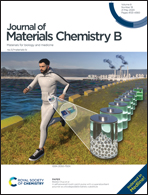Optical nanogap antennas as plasmonic biosensors for the detection of miRNA biomarkers†
Abstract
Nanoplasmonic biosensors based on nanogap antenna structures usually demand complex and expensive fabrication processes in order to achieve a good performance and sensitive detection. We here report the fabrication of large-area nanoplasmonic sensor chips based on nanogap antennas by employing a customized, simple and low-cost colloidal lithography process. By precisely controlling the angle for tilted e-beam metal evaporation, an elliptical mask is produced, which defines the total length of the dipole antenna nanostructures while assuring that the plasmonic response is oriented in the same direction along the sensor chip. Large-area sensor chips of nanogap antennas formed by pairs of gold nanodisks separated by gaps with an average size of 11.6 ± 4.7 nm are obtained. The optical characterization of the nanogap antenna structures in an attenuated total reflection (ATR) configuration shows a bulk refractive index sensitivity of 422 nm per RIU, which is in agreement with FDTD numerical simulations. The biosensing potential of the cm2-sized nanostructured plasmonic sensor chips has been evaluated for the detection of miRNA-210, a relevant biomarker for lung cancer diagnosis, through a DNA/miRNA hybridization assay. A limit of detection (LOD) of 0.78 nM (5.1 ng mL−1) was achieved with no need of further amplification steps, demonstrating the high sensitivity of these plasmonic nanogap antennas for the direct and label-free detection of low molecular weight biomolecules such as miRNAs.

- This article is part of the themed collection: Biosensors


 Please wait while we load your content...
Please wait while we load your content...